This rosehip facial oil is made with a simple infused oil using fresh or dried rose hips. This rose hip serum is wonderful for moisturizing, healing, and revitalizing dry or aging skin. With anti-inflammatory properties and many vitamins and minerals, rose hip face oil will soothe and protect the skin where you most need it!
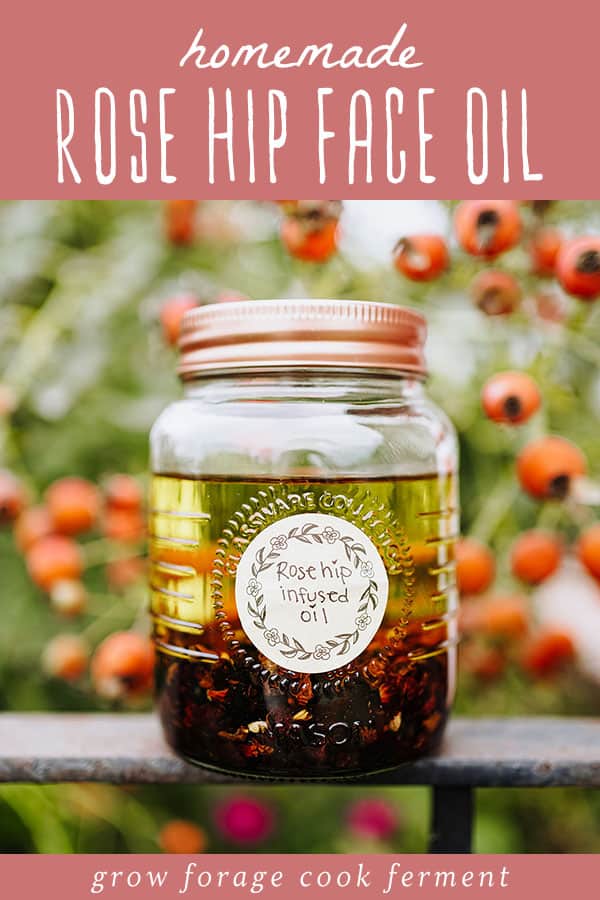
Want to save this post for later?
DIY Rosehip Facial Oil
Rosehip facial oil is an easy-to-make infusion that has wonderful soothing and anti-aging benefits for the skin. If you have freshly foraged rose hips, they are perfect to use in this recipe. Otherwise, dried rose hips work great too.
Any kind of rose hips can be used for this face oil. To harvest them fresh make sure they are red or orange in color and detach from the stem easily. Let them air dry for a day or two before making the oil for better results.
Don’t worry about removing the seeds and irritating hairs ahead of time, they will be strained out once the oil is infused.
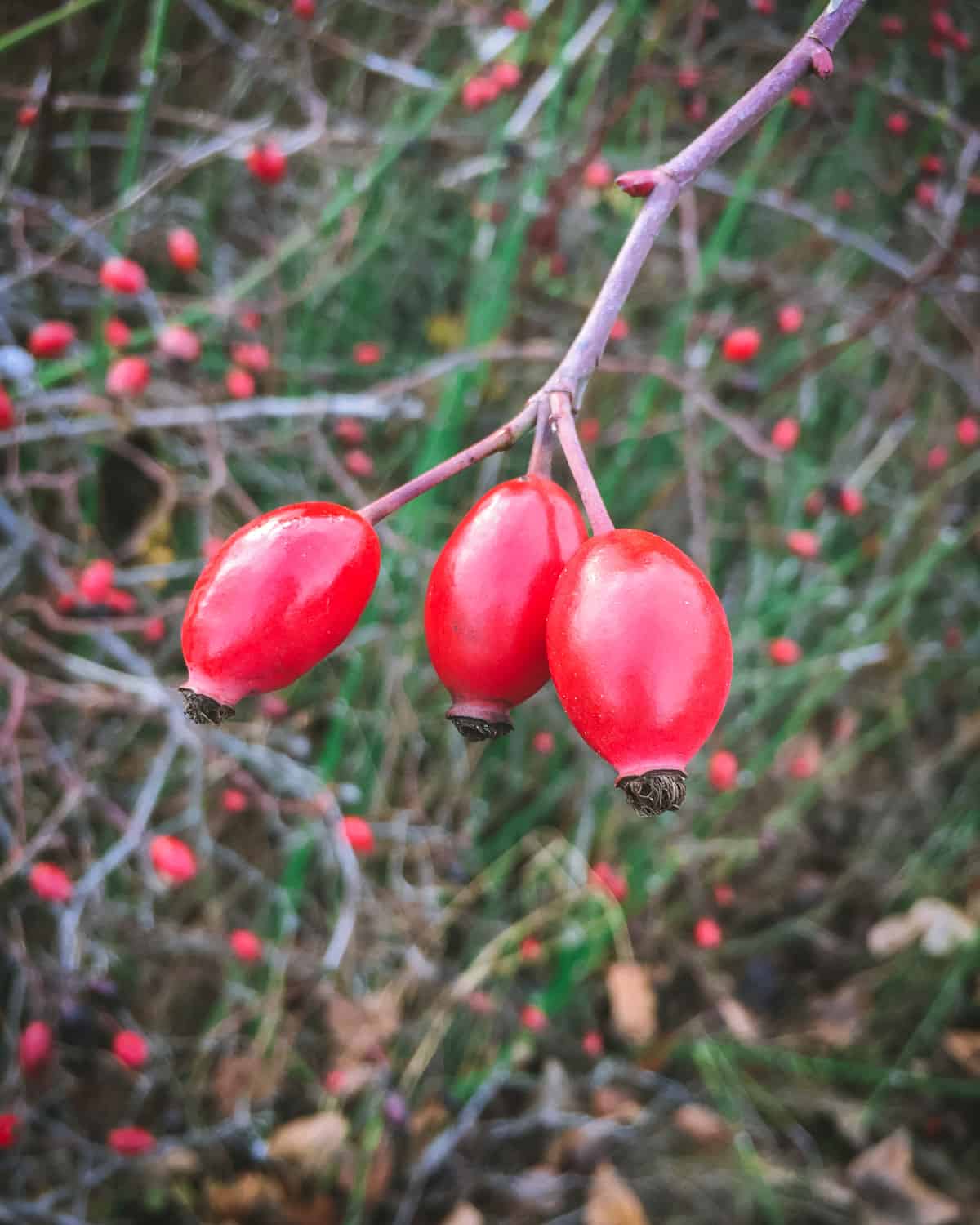
Rose hips have tons of skin benefits. When infused with skin-supporting oil they can moisturize, brighten, and reduce inflammation and signs of aging.
Use this rosehip oil on skin that is acne prone, red, dry, chapped, or scarred. The soothing, healing and calming results are unmatched!
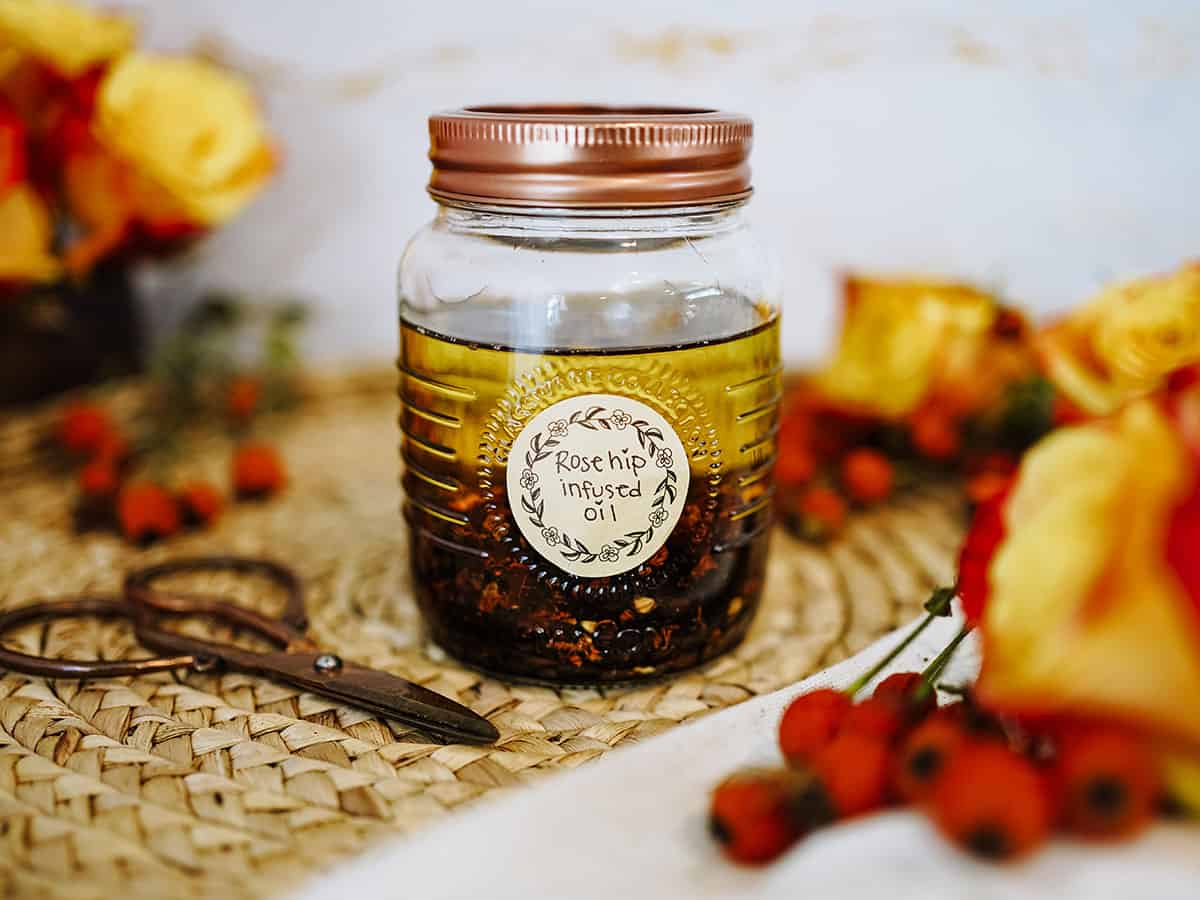
Ingredients
Jojoba oil is a popular carrier oil that works great for infusions, due to its stability. It absorbs into the skin wonderfully because it has similarities to our skin’s sebum.
Sweet almond oil is another wonderful carrier oil that has fatty acids as well as vitamins that are good for the skin.
Rosehips are the fruit of the rose plant that appear in fall and sometimes through winter in milder climates. They have one of the highest concentrations of vitamin C available. Along with being edible and nutritious, rose hips also have wonderful value and benefits for the skin.
How to Make Rose Hip Face Oil
Infuse the Oil
Put the rosehips in a 12 or 16 ounce jar. I used dried rose hips, but fresh ones can also be used.
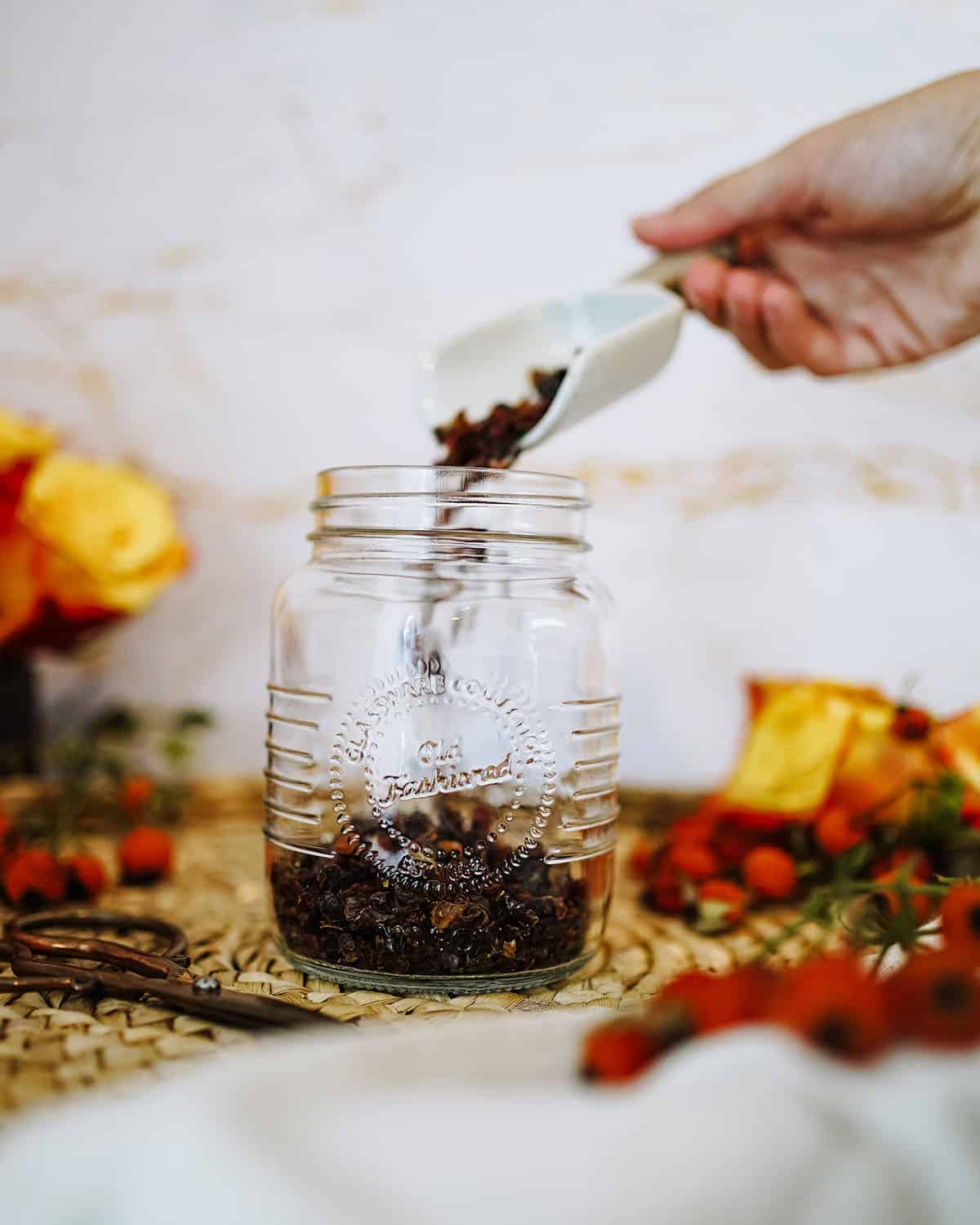
Pour the jojoba and sweet almond oil into the jar, they will be covering the rose hips. These oils together make a lovely infused oil that feels so soothing on your skin.
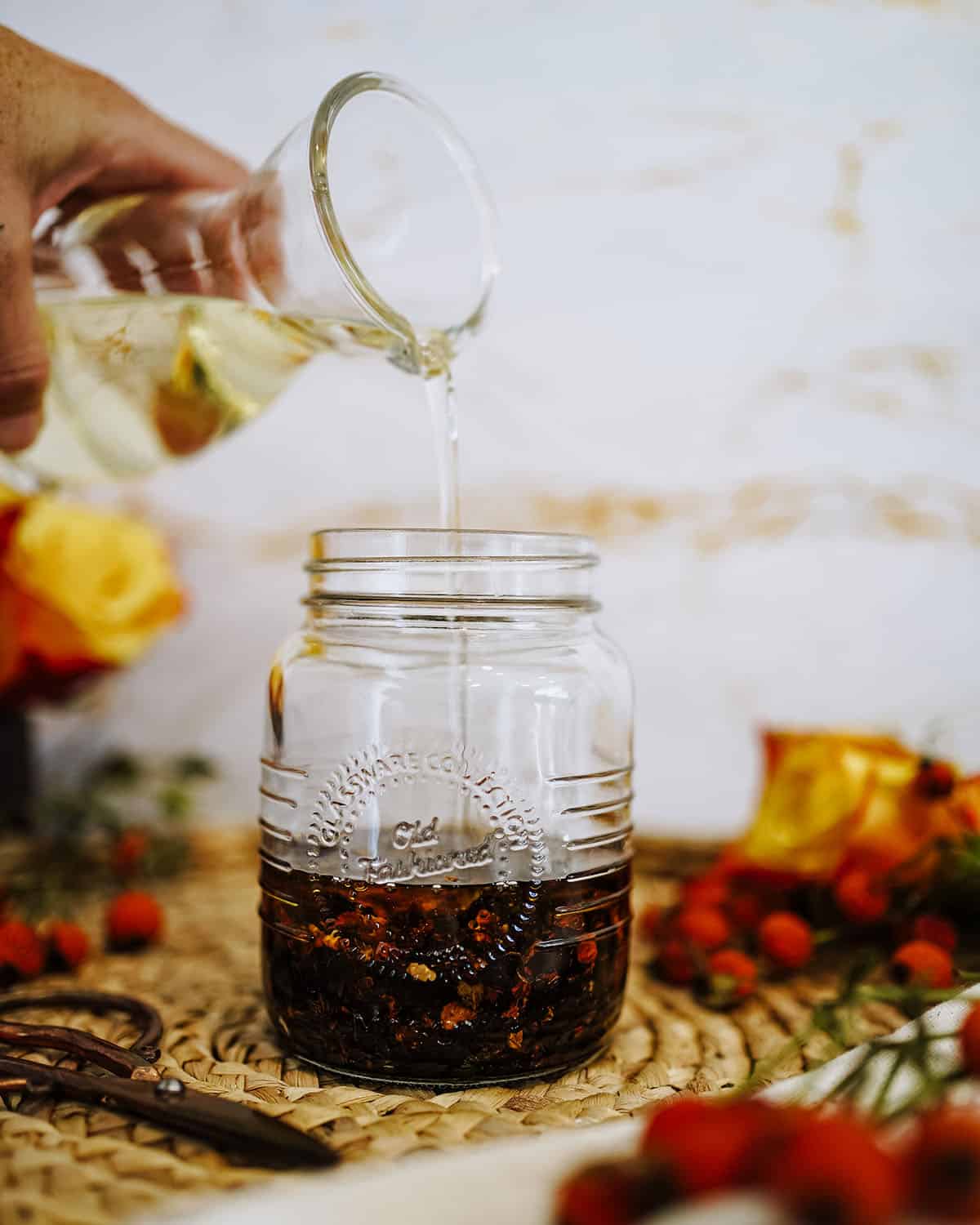
Slow-infused method: Cover and gently shake the jar to combine the oils and rosehips, then set it in a cool, dry, place that is out of direct sunlight. Leave it for 2-3 weeks to infuse.
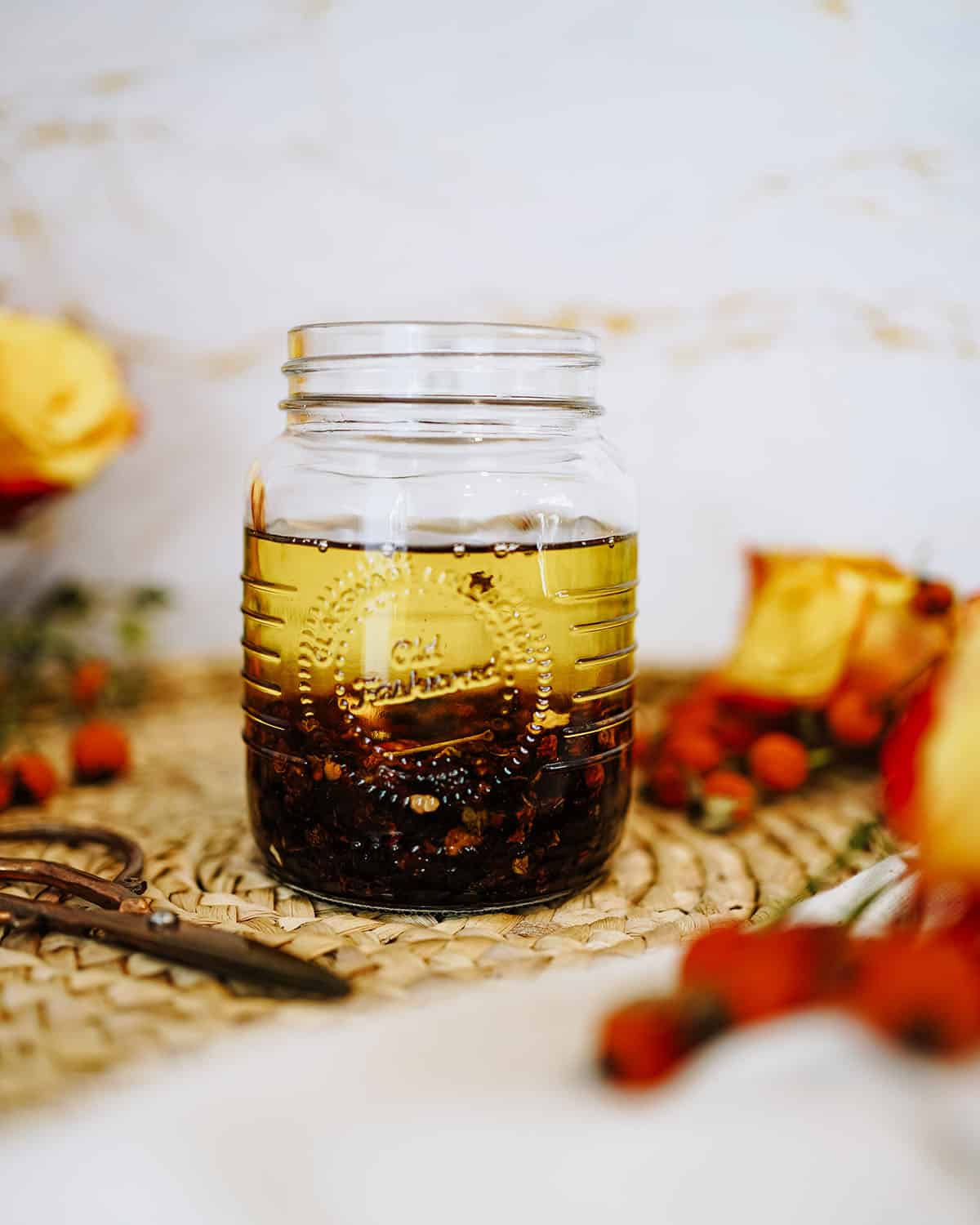
Quick heat-infused method: Fill a pot with water and set the jar of oil and rosehips into the pot. Simmer the pot on low for several hours to slowly heat the oil inside the jar.
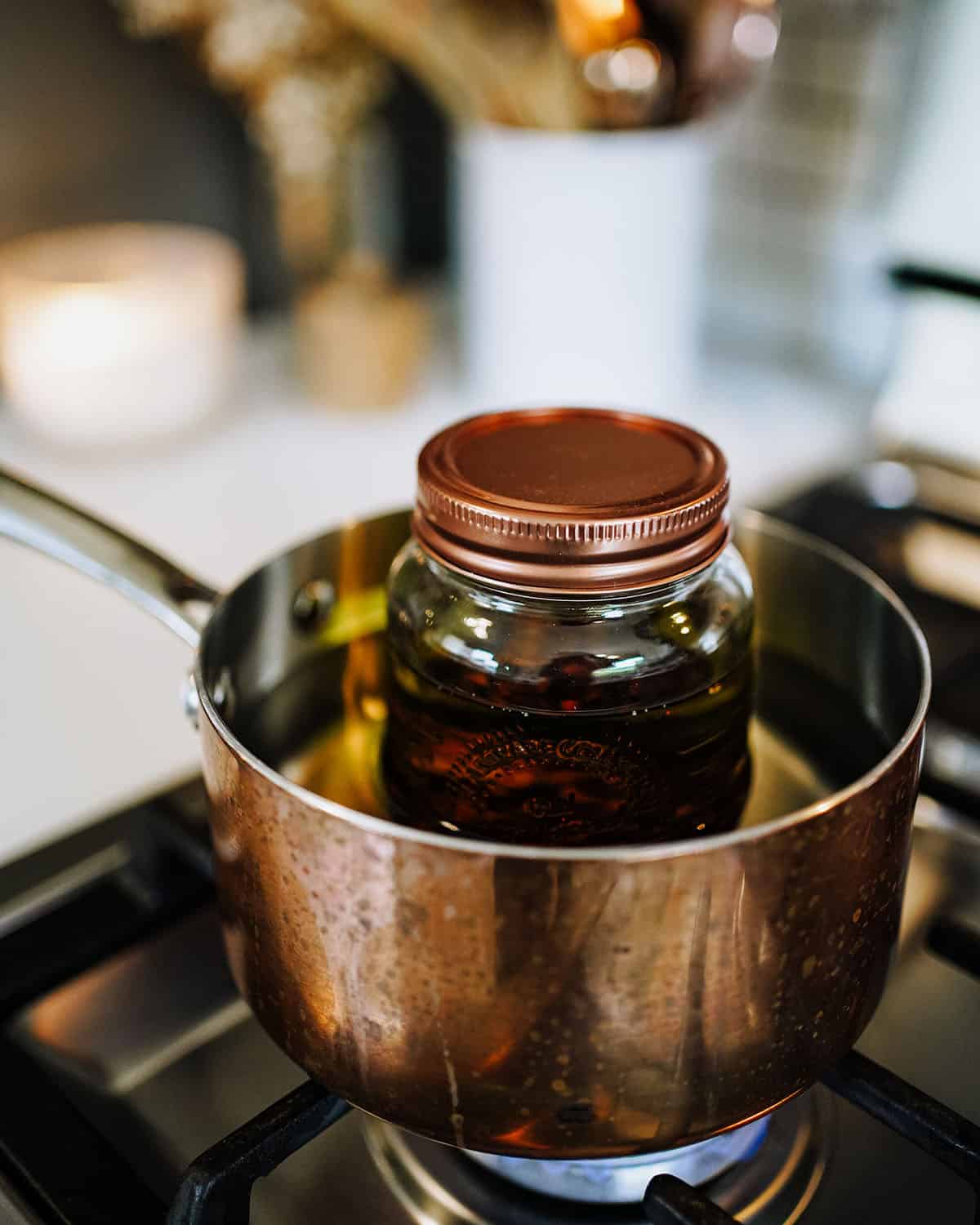
Once the jar and oils are warm, turn the stove off and let the jar stay in the warm water bath for the rest of the day. Once it is cooled completely at the end of the day, remove the jar from the pot to strain.
Strain the Oil
To strain the infused oil, pour it into a bowl or a measuring cup with a pour spout. I prefer a cup with a pour spout personally, it makes adding it to the small jars easier.
As you pour it into the measuring cup, use a mesh strainer lined with cheesecloth to strain out the rose hips.
If you are using foraged rose hips, I recommend using several layers of cheesecloth (or even a coffee filter) and a fine mesh strainer to strain out the seeds and irritating rosehip hairs.
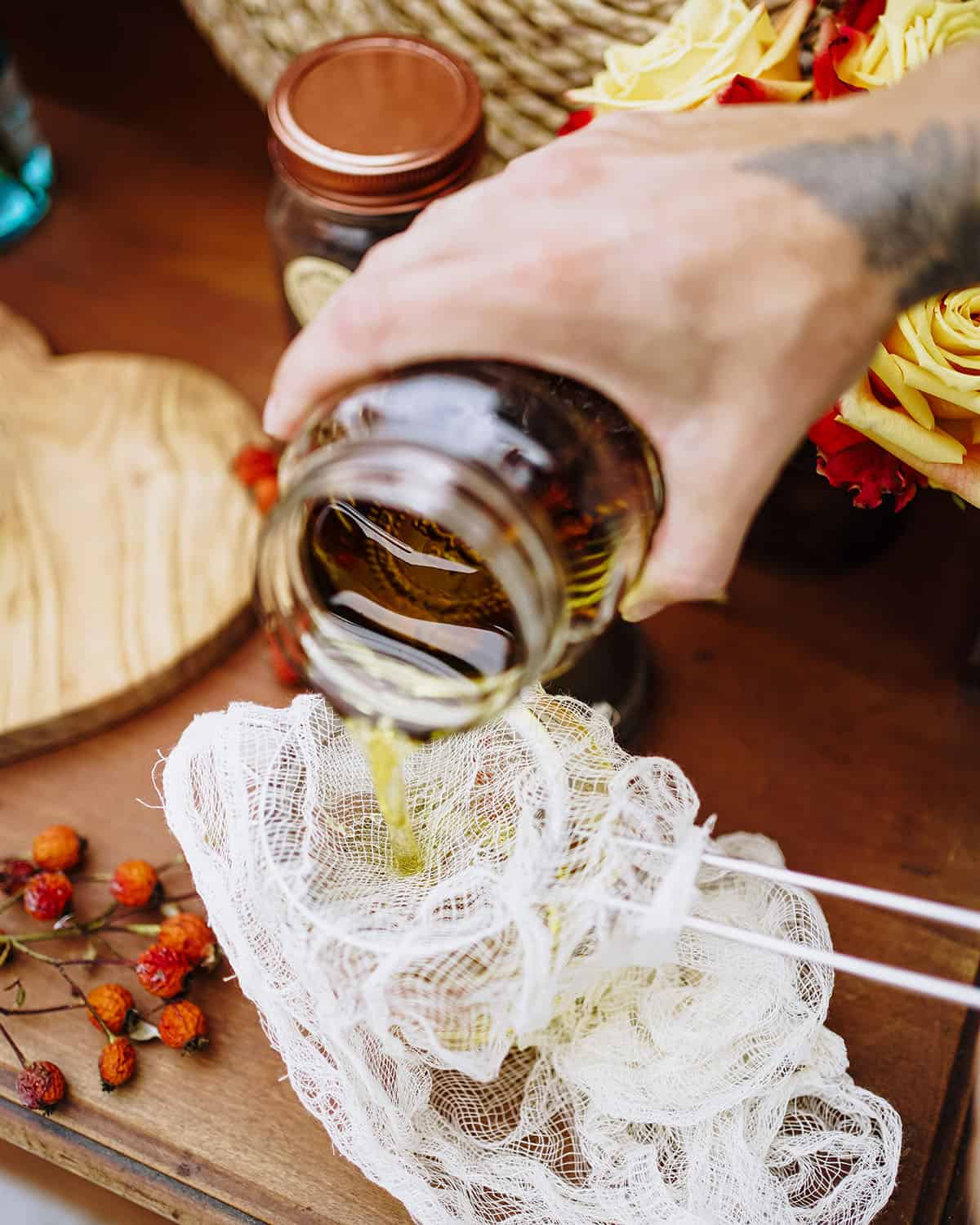
Transfer and Store
Once the oil is completely strained, transfer it to your bottle of choice.
To store rosehip facial oil, use a dark bottle that will protect the oil from light, and keep it in a cool place. I really like these dropper bottles from Mountain Rose Herbs.
During hot summers without air conditioning, I recommend storing the rosehip serum in the refrigerator.
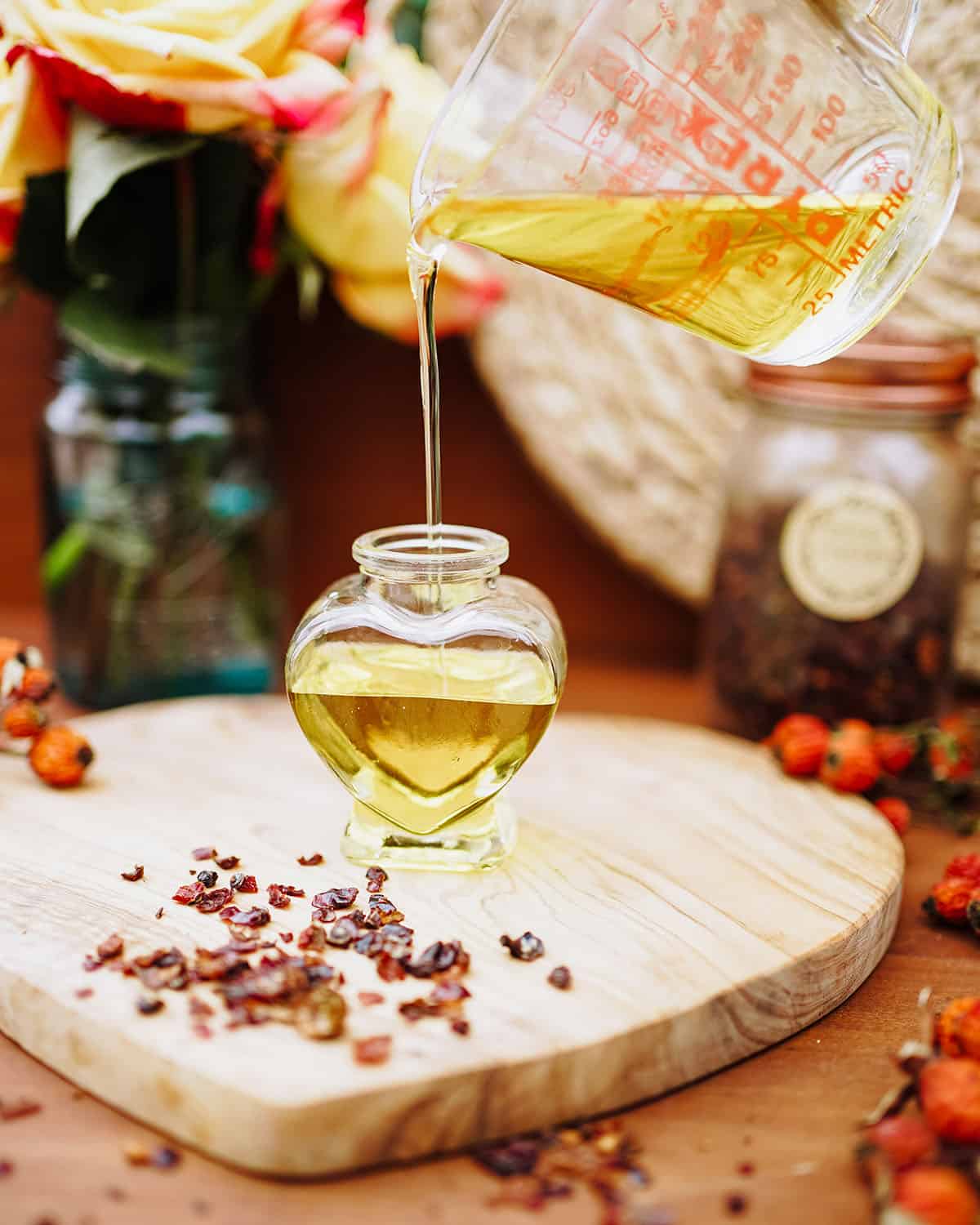
How to Use Rosehip Facial Oil
Use rosehip facial oil in the morning and evening. Layer it on underneath any creams over your face, neck, and decolletage.
This soothing serum can be applied on your shoulders and back as needed if there are areas of redness, irritation, dryness, or blemishes.
Rosehip serum is good for dry, aging, sensitive, and acne-prone skin. It has also been known to help balance out uneven skin tone and reduce the appearance of scars.
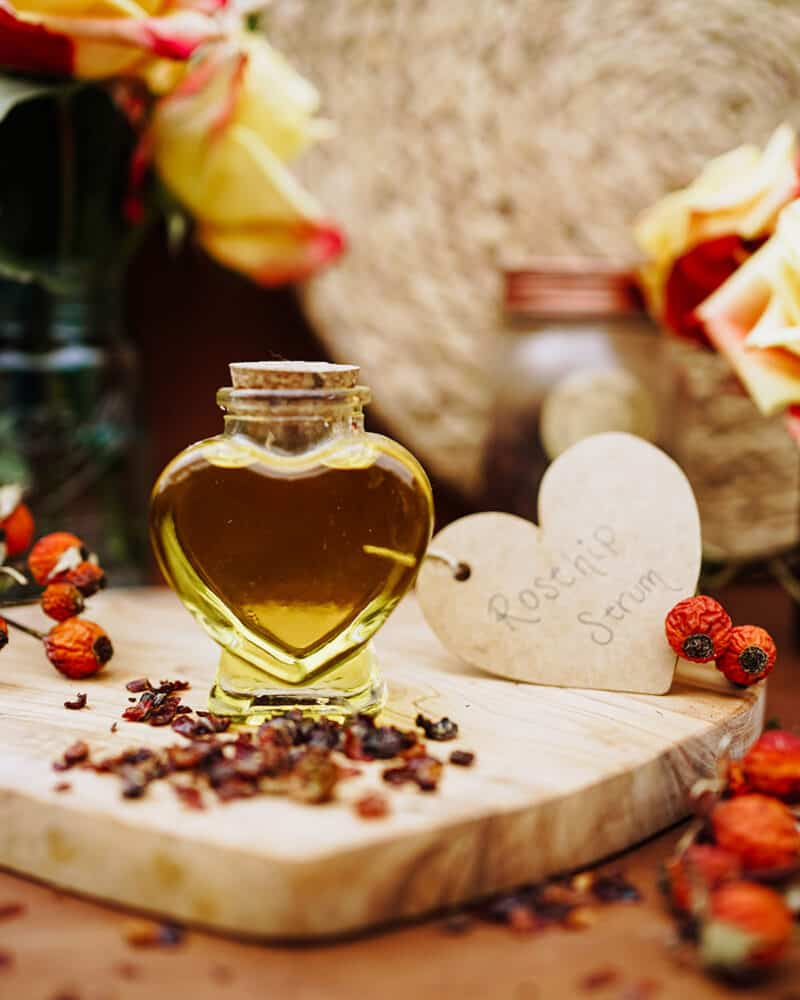
This infused oil soaks in beautifully and will heal and revitalize your skin giving you a healthy glow as well as reducing wrinkles, inflammation, and blemishes.
This rose hip serum has a lovely scent, and rich texture and is a perfect herbal skincare recipe to try. With how easy it is to make, and how soothing and effective, there is no reason not to!
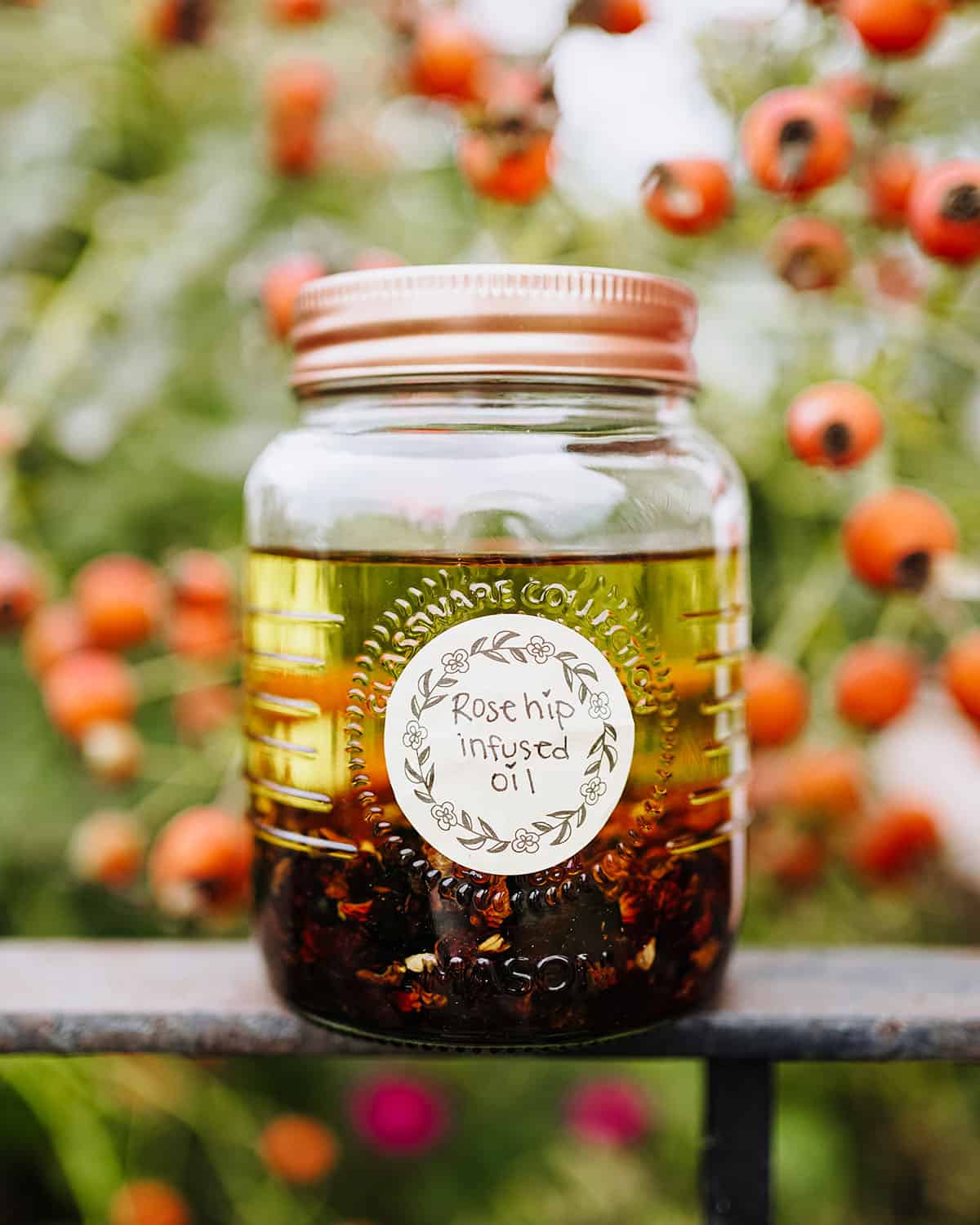
Can rosehip serum be used together with vitamin C serum?
Yes! These two serums are known to complement each other well.
Can rosehip facial oil be used as a moisturizer?
This infused oil can be used as a moisturizer. It will soften and hydrate, so it will depend on your skin’s needs. If your skin produces too much oil, using an oil like this will signal your skin to not overproduce its own oil and may be all you need.
However, if your skin is excessively dry, you may need to still use a cream. Try a few things out to see what works best for you!
More rose hip recipes to try:
- Rose Hip Tea with Fresh or Dried Rose Hips
- Homemade Vitamin C Gummies with Rosehips
- Rose Hip Syrup: Foraged and Made with Honey
- Reishi Mushroom Infused Red Wine with Rose Hips
- Rose Hip Lip Balm for Soothing Dry Lips
- Rose Hip Whiskey Smash: Foraged Fall Cocktail
Rosehip Facial Oil
Equipment
- Dropper Bottles or bottle of choice
Ingredients
- 4 ounces jojoba oil
- 8 ounces sweet almond oil
- 4 ounces dried rose hips or 8 ounces fresh rose hips
Instructions
Make the Infused Oil
- Fill a 12 or 16 ounce glass jar with 4 ounces of fresh or dried rose hips (or 8 ounces fresh rose hips that have been air dried for a day or two). Pour in 4 ounces of jojoba oil, and 8 ounces of sweet almond oil.
Slow Infused Method
- To slow infuse, gently mix the closed jar and leave it in a cool dry place for about 2 weeks. Now it is ready to strain.
Quick Heat Infused Method
- To heat infuse, fill a pot with water and place your rose hip oil jar inside the pot. Allow the pot to simmer on low for several hours, slowly heating the jar and oil inside. Turn off the heat from the stove and let the jar rest in the hot water bath for the rest of the day as it cools. Carefully remove your jar to get it ready to strain.
To Strain the Infused Oil
- Using a fine mesh strainer and cheesecloth, pour the rose hip oil into the strainer. If you are using foraged rose hips, I recommend using several layers of cheesecloth (or even a coffee filter) and a fine mesh strainer to strain out the seeds and irritating rose hip hairs.
- Transfer the strained oil into a glass dropper bottle (or bottle of choice).
Notes
- If you are using freshly foraged rose hips it’s best to let them air dry for a day or two before using for best results.
- When straining, I like to catch all that wonderful infused oil into a measuring cup. That way it is easy to use the spout to transfer it into the final bottle.
- This rose hip serum has a lovely scent and a rich texture, and is a perfect herbal skincare recipe to try.
- I recommend a dark glass bottle to store rose hip facial oil, so it is protected from light and heat.
- In a very hot season, it may be beneficial to store this infused oil in the refrigerator.


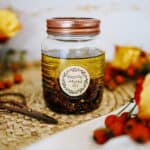

I have frozen rosehip. Can they be used to make the serum?
Yes, that should be fine!
My herbalist friend and doctor always says rose oil is awesome for the skin. I will definitely make this as roses are everywhere I walk. I made rose cheong sirup a few weeks ago, which is also fabulous. My question is which extraction method do you prefer? Does the heated method bring more of the healing properties out of the hips or destroy some of them? Thank you.
You’ll get more the beneficial properties with the slow-infusion method!
Are the rose hips 4 oz by weight or 4 oz in a measuring cup? I’m assuming the oils are by the cup. I’m very excited to try this. Thanks!
All of the ingredients are by weight.
Hi I have a questions! Do you normally cut the rose hips in half before drying them? I normally do but I find it quite time consuming and have heard it’s not necessary. Thanks!
Hi there. I think it’s unnecessary to cut them in half before drying!
What happens if I don’t put my infused oil in a water bath and go directly to staining it and making a lip balm? Did I lose some of its elements,? I also used rosehips, full that I foraged
You’ll need to let the oil infuse to extract any benefits. Either slowly over a double boiler or by letting it sit in the jar for two weeks or more.
Im confused! I thought oils had to be made with dried plant material to keep the oil from watering and going bad? :D
This is made with dried rose hips.
Any rose will work I have 2 big knockout roses and they are full of hips
This sounds great and would also make a lovely little Christmas gift🙂 How many weeks or months does it keep, please?
At least a year when stored in a cool place out of direct sunlight.
Can I use olive oil or coconut oil for this recipe?
Coconut oil isn’t recommended because it can clog pores, but you can try olive oil if you prefer.
This recipe is awesome, I love this face oil! Do you know if you can reuse the dried hips in a second round of oil infusion after straining, or would it be less effective?
Hi Britta. I’m so glad you liked this recipe. Reusing the dried hips in a second healing herbal infusion will definitely be less effective. I would start a new batch.
Thank you!
Hi! Do I need to cut open my dried, foraged rose hips for this recipe or leave them whole?
Thank you!
No, you can leave them whole.
I’m glad to read that they can be used whole – I initially started cutting them up and my hands got so itchy from all those little hairs! I am afraid I would accidentally leave some of them in my oil.
Interesting! can I infuse them in flaxseed oil instead?
Sure!